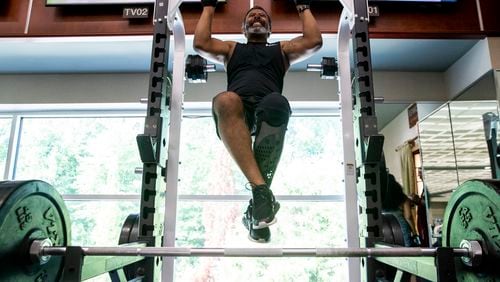If you went to an American public school between 1966 and 2012, you probably have memories of sweating through the Presidential Physical Fitness Test — a gym class gauntlet that involved a mile run, situps, pullups (or pushups), a sit-and-reach and a shuttle run.
For those who were athletically inclined, it was a chance to shine: Children who scored in the top 15% were honored with a Presidential Physical Fitness Award. (At my elementary school, those kids got their names painted on the gym wall.) For those who weren’t, it could be a source of dread: proof that you just weren’t cut out to exercise. Anyone else remember hanging in vain from a pullup bar?
Born of Cold War-era fears that America was becoming “soft,” the test was first introduced by President Lyndon Johnson in 1966. The goal was to improve the fitness of the nation’s youth for military service, said Dawn Coe, an associate professor of kinesiology at the University of Tennessee, Knoxville. The original test also included a softball throw, which mimicked throwing a grenade.
President Barack Obama got rid of the test in 2012, replacing it with an assessment called the FitnessGram that is less about besting your classmates and more about improving individual health. “It’s no longer a one-size-fits-all approach,” Coe said.
Some of us who struggled with the test later found ways to appreciate exercise — and made peace with the fact that some parts blatantly favor certain body types.
But if you’ve ever wondered how your older, wiser (and maybe buffer) self would fare on the Presidential Physical Fitness Test, I asked experts how each of the events holds up as a measure of fitness today. With a few updates and modifications, it can provide useful insights into your cardiovascular fitness, strength and flexibility, all of which are key for quality of life and longevity.
Most importantly, when you test yourself today, focus on your own fitness level and progress, experts said, and remember that health is not a competition. It’s not about how many pullups you can do, it’s about feeling stronger over time — and maybe even being able to tackle new challenges.
1. THE MILE RUN
The test: Run or walk a mile at a challenging pace and time yourself.
What it gets right: This is a simple measure of cardiovascular health and endurance. If you’re in excellent aerobic condition or an experienced runner, it can also be a fun way to find your upper limit of speed, said Rick Richey, a master trainer for the National Academy of Sports Medicine in New York. (If you’re curious, compare your time with others your age.)
What it gets wrong: The focus on speed is arbitrary, and the test can be an exercise in pain and exhaustion that turns people off from running. A more important question than speed, Richey said, is: “How much are you challenging your cardio respiratory system?”
How to use it today: If you’re a beginner, start by walking a mile, then gradually incorporate running intervals. Along the way, make a mental note of how the exercise feels. If you can increase your speed over time or feel increasingly better while going at the same pace, you’re winning, Richey said.
2. THE PULLUP
The test: Using a pullup bar, start in a full hanging position with your knuckles either facing away or toward your face (kids got to choose, though the former is generally easier). Pull up until your chin is above the bar. Count how many you can do, no time limit.
What it gets right: Pullups and chin-ups are a good measure of upper body strength — in theory.
What it gets wrong: Many people simply do not have the strength or physiology to get all the way up without specific training.
How to use it today: If you’re intrigued by the challenge, doing a pullup is a worthwhile and achievable goal. The exercise develops your back, shoulder and arm muscles, as well as your grip strength, which is linked to a longer, healthier life.
If full pullups feel out of reach, start by seeing how long you can hang from a bar, Richey said. Move onto the flexed arm hang, then assisted pullups with resistance bands, which make it easier to lift yourself up. Gradually work your way up to an unassisted pullup.
… OR THE PUSHUP
The test: Schools had the option of giving kids either a pullup or pushup test, though many chose the former. Perform as many pushups as you can until failure. No time limit.
What it gets right: Exercise scientists agree that the pushup is a gold standard test, not only of upper body strength, but full-body strength and endurance, because it requires awareness of every part of your body, from head to toes.
What it gets wrong: Nothing, if done correctly. But it’s important to do pushups with proper form — starting in a plank position, making sure your belly doesn’t drop and your back doesn’t arch. It’s better to do one properly than five with poor form.
How to use it today: ”I love teaching pushups, because it’s such a wonderful way for people to really rewrite their story about their capabilities and their strength,” said Cadence Dubus, founder of the Brooklyn Strength virtual training program.
If you’re able to do a pushup, see how many you can do before your form suffers, then immediately stop. Don’t focus on a particular number, focus on improvement. If you’re a beginner, start with modified pushups with your knees on the ground.
3. THE SITUP
The test: Technically a curl up, this exercise is a partial situp, done with your back in a C-shape and your arms crossed over your chest. The Presidential Physical Fitness Test required doing as many as possible in 60 seconds — usually with another kid sitting on your feet to hold them.
What it gets right: Not a lot.
What it gets wrong: More than any of the other events, the curl-up test raises the eyebrows of modern exercise scientists. Not only does it have the potential to exacerbate back pain by stressing the lower spine but it only works the front layers of core muscles.
What to do instead: A better way to train and test your core strength, which is important for long-term health, is to time how long you can hold a plank while maintaining proper form, said Mary Winfrey-Kovell, a lecturer in exercise science at Ball State University.
If you’re new to the exercise, start with a modified plank, keeping your knees on the floor, or do a standing plank with your forearms on the wall. As you gain core strength, transition to classic planks, and strive to work up to a 60-second hold.
4. THE SHUTTLE RUN
The test: Run back and forth between two lines, 30 feet apart, two times, as quickly as possible. Each time you cross a line, pick up a block of wood (or chalkboard eraser) and drop it at the other line.
What it gets right: The shuttle run tests speed and agility.
What it gets wrong: If you aren’t already doing speed or agility training in your daily life, experts advise against taking this test.
“When I think of the shuttle run in adults, I just think of injuries,” said Dr. Calvin Duffaut, a sports medicine physician and team doctor for UCLA Athletics. “The changes in direction — if someone doesn’t have the background in it, I worry.”
What to do instead: Schools have replaced the shuttle run with the beep test, which requires you to accelerate and decelerate but doesn’t require you to quickly change direction as quickly. This makes the beep test safer than the shuttle run, Duffaut said.
That said, working on your agility — which includes your ability to change directions on a dime — can be beneficial in both recreational sports such as pickleball and in daily life. You can also test and improve your agility with exercises like lateral plyometric jumps, gradually increasing your speed each week.
5. SIT AND REACH
The test: Take your shoes off and sit with your legs straight against a sit-and-reach ruler box. Lean as far forward as possible. (If your school didn’t have a ruler box, you may have done the V-sit reach, which simply requires sitting with your feet 8 to 12 inches apart and noting how far you can reach.)
What it gets right: This test measures how far you could reach, which can reflect lower back and hamstring flexibility.
What it gets wrong: These tests aren’t exactly fair — people with relatively short arms or long legs are at a disadvantage, Richey said. (He could do a split in three directions, he said, but still scored poorly on the sit-and-reach.)
How to use it today: If you’re only competing against yourself and using proper form — hinging from your hips and not rounding your back — how far you can reach can be decent measure of flexibility, Richey said.
“Being able to reach your own foot and ankle is something that you can lose, and that can have consequences,” Dubus added. The more you practice sitting and reaching, the easier it will become, especially when combined with stretches that improve hip mobility, such as the 90/90 stretch.
About the Author






